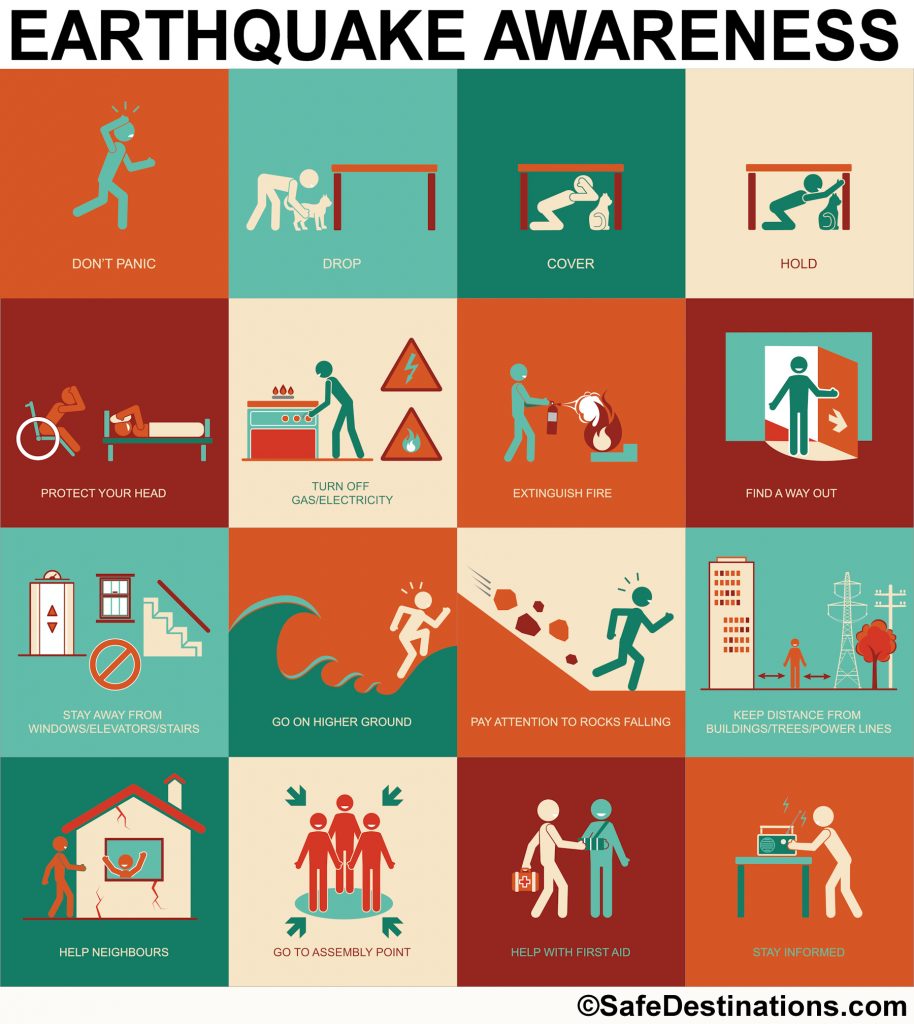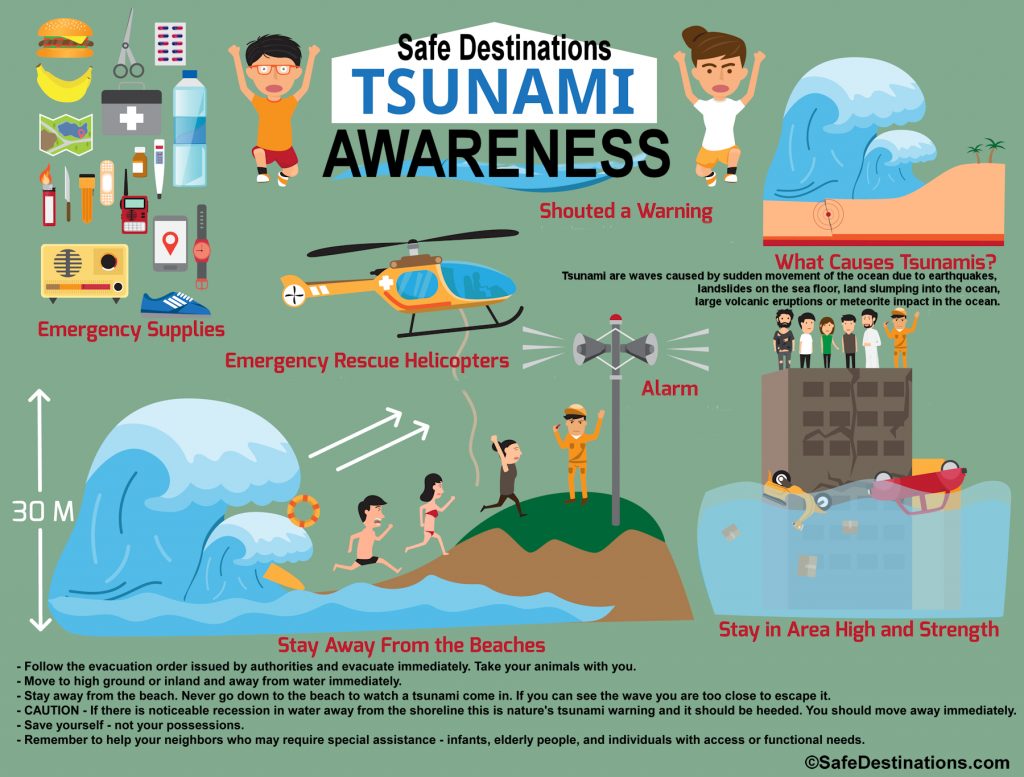Countries with the most Earthquakes & Natural Disasters
 Some sort of natural disaster can happen almost anywhere at almost anytime. Floods, wildfires, droughts, volcanoes, and avalanches can occur in any season. While no spot on the planet is immune from natural disasters there are countries that see more occurrences of devastating disasters due to their geographic location.
Some sort of natural disaster can happen almost anywhere at almost anytime. Floods, wildfires, droughts, volcanoes, and avalanches can occur in any season. While no spot on the planet is immune from natural disasters there are countries that see more occurrences of devastating disasters due to their geographic location.
The United States is second on the list of top 10 countries that experience the most natural disasters yet it is also one of the most popular safe destinations for traveling and vacations. Common-sense, caution and preparedness are always good procedures for self-preservation. If it is possible to adjust the timing of vacations to avoid rainy seasons or particularly harsh seasonal temperature fluctuations, you can mitigate the risk when you travel.
Below is the list of the 10 countries which have averaged the most natural disasters per year. While the threat to life is extreme in severe natural disasters most travelers and vacationers will experience more risk from people than from such disasters. Caution is always advised when choosing a vacation destination but factors like political strife, wars, financial instability and religious conflicts should take precedence when deciding on a holiday.
| Countries With Most Annual Natural Disasters | ||||||
| Rank | Country | Climatological | Geophysical | Hydrological | Meteorological | Total |
| 1 | China | 2 | 8 | 15 | 15 | 40 |
| 2 | United States | 2 | 1 | 3 | 14 | 20 |
| 3 | India | 0 | 0 | 8 | 7 | 15 |
| 4 | Japan | 0 | 2 | 1 | 10 | 13 |
| 5 | Philippines | 0 | 1 | 3 | 9 | 13 |
| 6 | Indonesia | 0 | 2 | 8 | 0 | 10 |
| 7 | Mexico | 0 | 2 | 0 | 6 | 8 |
| 8 | France | 0 | 0 | 3 | 5 | 8 |
| 9 | Thailand | 1 | 1 | 4 | 2 | 8 |
| 10 | Nepal | 0 | 0 | 6 | 1 | 7 |
Climatological: extreme temperatures, drought, and wildfires.
Geophysical: earthquakes, landslides, tsunamis, and volcanic activity.
Hydrological: avalanches and floods.
Meteorological: cyclones and storms/wave surges.

Earthquakes
Every year, on average, there are approximately 1,800 earthquakes recorded that are over 5 on the Richter scale. The risks of fatality are lower in most of these earthquakes. Devastating earthquakes, above 7 on the Richter scale and ones that cause massive loss of life, are rare occurring on average 7 times per year world-wide.
| Major Devastating Earthquakes in last 116 Years | ||
| Country | Total Earthquakes | Per Year |
| China | 157 | 1.35 |
| Indonesia | 113 | 0.97 |
| Iran | 106 | 0.91 |
| Turkey | 77 | 0.66 |
| Japan | 61 | 0.53 |
| Peru | 44 | 0.38 |
| USA | 41 | 0.35 |
| Italy | 33 | 0.28 |
| Afghanistan | 32 | 0.28 |
| India | 32 | 0.28 |
| Greece | 32 | 0.28 |
| Mexico | 32 | 0.28 |
The Pacific coasts of North America bordering the Pacific Ocean and the Eastern coasts down Eurasia and through Pacific Oceania are recognized as zones of earthquake as well as potential volcanic activity. These areas include many popular tourist destinations and while no-one would seek out a vacation with earthquakes as part of their itinerary, the rarity of earthquakes makes it something that most of us can put as a low-level threat to our enjoyment of a vacation.
The Mediterranean and into India and Indonesia are also areas where risk of geological activity is present. There are many warm, desirable destinations in these areas as well that are popular for travellers and the most anyone can do to avoid problems is to watch for any indicators of potential earthquakes released by local authorities.
| Largest Recorded Earthquakes since 1833 | |||
| Rank | Country | Event | Magnitude |
| 1 | Chile | 1960 Valdivia earthquake | 9.4–9.6 |
| 2 | United States | 1964 Alaska earthquake | 9.2 |
| 3 | Indonesia | 2004 Indian Ocean earthquake | 9.1–9.3 |
| 4 | Japan | 2011 Tōhoku earthquake | 9.1 |
| 5 | Russia | 1952 Kamchatka earthquakes | 9 |
| 6 | Chile | 1868 Arica earthquake | 8.5–9.0 |
| 7 | Indonesia | 1833 Sumatra earthquake | 8.8 |
| 8 | Ecuador – Colombia | 1906 Ecuador–Colombia earthquake | 8.8 |
| 9 | Chile | 2010 Chile earthquake | 8.8 |
| 10 | India – China | 1950 Assam–Tibet earthquake | 8.7 |
| 11 | United States | 1965 Rat Islands earthquake | 8.7 |
| Earthquake Magnitude Scale | ||
| Magnitude | Earthquake Effects | Occurances Per Year |
| 2.5 or less | Usually not felt, but can be recorded by seismograph. | 900,000 |
| 2.5 to 5.4 | Often felt, but only causes minor damage. | 30,000 |
| 5.5 to 6.0 | Slight damage to buildings and other structures. | 500 |
| 6.1 to 6.9 | May cause a lot of damage in very populated areas. | 100 |
| 7.0 to 7.9 | Major earthquake. Serious damage. | 20 |
| 8.0 or greater | Great earthquake. Can totally destroy communities near the epicenter. | Once every 5 – 10 years |
Nepal is a seismically active area and a citizen in Nepal is two times more likely to be killed in an earthquake than any other civilian in the world.
Some of the most desirable vacation destinations are also located in regions where earthquakes are a regular part of life to a certain extent. Such places like Japan have a long history of disastrous earthquakes which has not diminished the number of visitors who seek the countries unique culture and landscape.
Nepal is also an active area and has one of the highest rates of death by earthquake per capita than any other country. Attractions like Tilicho Lake, Chitwan National Park, and Mount Everest continue to draw tourists despite the elevated risk of seismic activity.
India is also in an active belt and South America has been hit with some of the largest recorded earthquakes in history. While the Chilean earthquakes have historically not been the most devastating for total loss of life compared to other countries the fact that extremely high magnitude earthquakes occur in this South American region mean that the risk should be considered potentially elevated, especially in Chile.
Pakistan and the Philippines are also countries that experience earthquakes more frequently and often the damage and loss of life is increased when such disasters occur in poor countries or where the infrastructure is unable to handle the large number of injuries. When natural disasters occur in poorer countries tourists may find that items that are taken for granted at home are hard to come by even if they are vacationing in a resort in a poorer country.
Countries like Turkey are not only earthquake prone countries but also part of regional political conflicts making travel to such countries rank lower for multiple reasons, not just earthquakes.
